The OKR Planning Session [+ template and agenda]
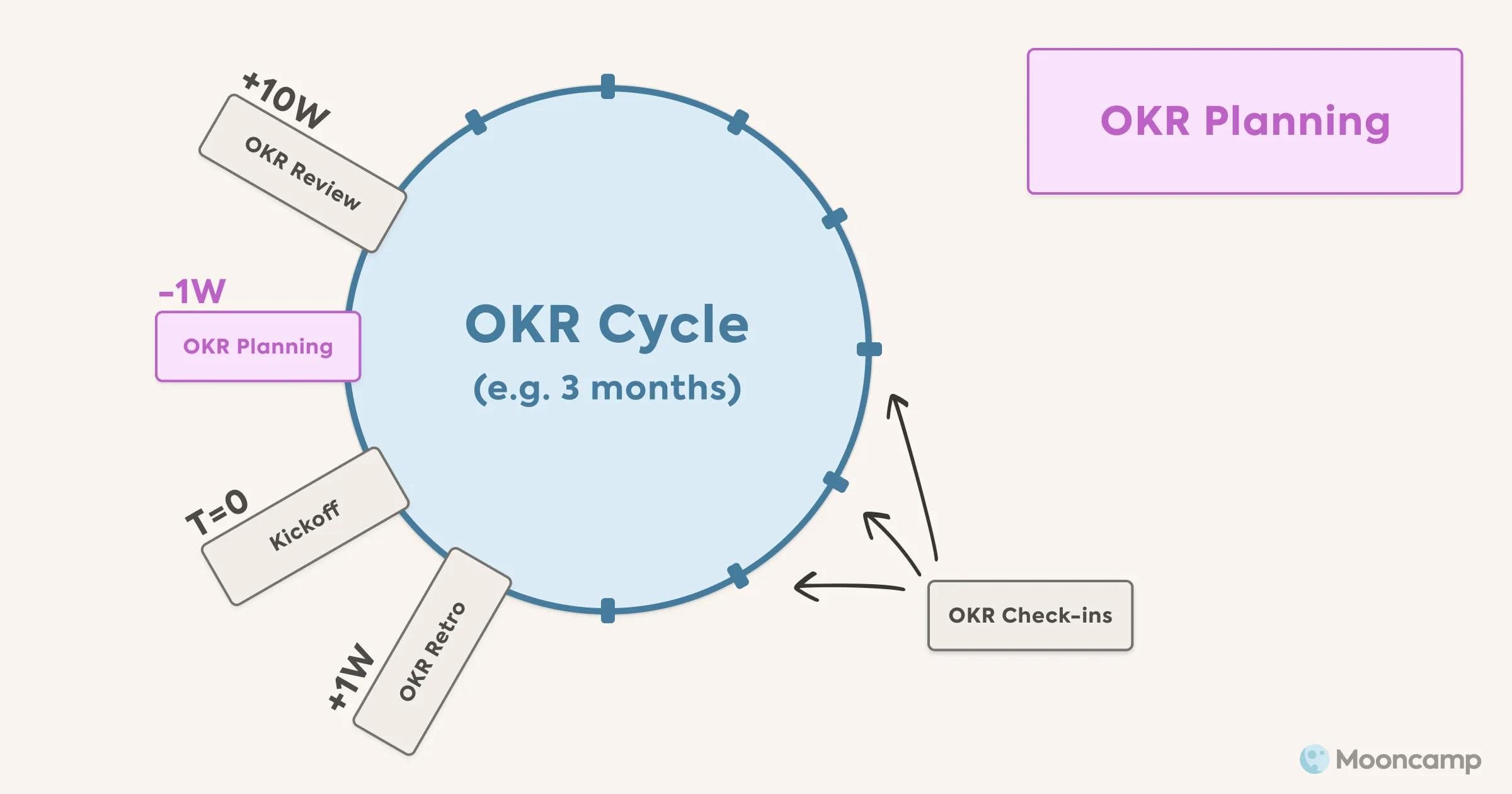
Finding the right OKRs for each cycle during OKR Planning can be tedious. This makes it all the more important to ensure that the brainstorming and OKR planning process is well-structured. In this article, we explain how best to conduct an OKR planning session in practice – including an agenda and checklist for preparation.
What to expect:
- What is OKR Planning?
- The purpose of OKR planning sessions
- Preparing the OKR planning session: Checklist and factsheet
- How to conduct an OKR Planning meeting
- How to plan OKRs with Mooncamp
- OKR Planning: FAQ
What is OKR Planning?
OKR Planning (or OKR Setting) is the first event in each OKR cycle. It involves brainstorming and formulating the Objectives and Key Results for the next cycle and usually takes place as a workshop or meeting.
The planning is done on several levels: for the entire company, departments and individual teams. However, the principle and process of the meeting remain largely the same. The only difference is the context to which the Objectives and Key Results to be created relate.
💡 Reminder: OKRs (short for "Objectives and Key Results") are an agile framework for formulating and implementing strategic goals in companies that – if used correctly – leads to more flexibility, transparency and success. It consists of three core elements:
- Objectives: What do I want to achieve?
- Key Results: How do I know the goal has been reached?
- Initiatives: How do I achieve the goal?
Typically, a total of 2 to 4 Objectives per team and 2 to 4 Key Results per Objective are formulated. The output is mapped into initiatives (= concrete activities). More basic knowledge is available in our OKR guide.
The purpose of OKR planning sessions
The purpose of OKR planning sessions is to develop draft OKRs that will strategically advance the company in the next cycle (usually one quarter). To do this, the OKRs are planned so that each one impacts one of the high-level OKRs.
In the initial OKR planning session, management translates the company's vision and mission into strategic company OKRs. In subsequent planning workshops, departments and teams create OKRs that impact at least one of the company OKRs.
Preparing the OKR planning session: Checklist and factsheet
To ensure that the OKR planning session is as productive as possible and does not drag on unnecessarily, some preparations should be made in advance.
- All participants should be informed in a timely manner, preferably at least one month in advance, when the workshop will take place.
- The company's mission, vision and current priorities should be known to all participants. If this is not already the case, they should be explicitly communicated one more time before the workshop.
- All participants should think about possible Objectives before the meeting. They should receive the (preliminary) agenda at least two weeks before the meeting.
- For OKR planning sessions at team level, the company Objectives should be communicated to all participants in advance. The (senior) manager in particular should also derive possible Objectives and Key Results for the team from the company OKRs and bring them to the meeting as suggestions that can be discussed.
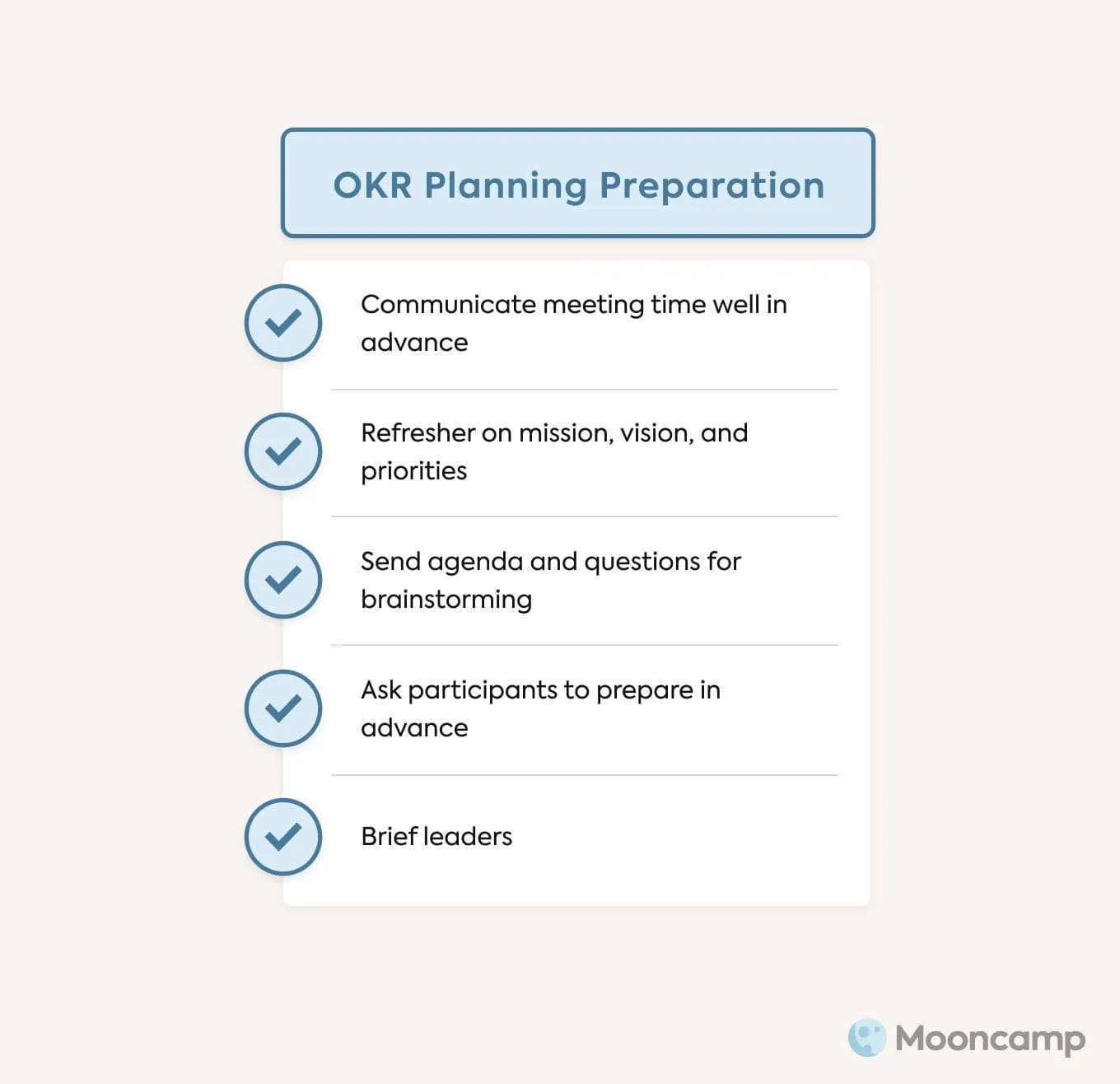
To stimulate the participants' creativity and to put everyone in the right mindset, it can also be useful to send some questions into the round in advance. Possible food for thought for the brainstorming session could be:
- What is currently not working?
- What is blocking our current progress?
- What would need to happen to solve this problem?
- Do we still align with the company vision?
- Where do we want to go?
- What would be specific goals to achieve?
- Do these goals align with current priorities in the company?
- Are the goals ambitious but focused? Are they clear and easy to understand?
You should also determine early on where the OKR planning meeting will take place (e.g., in person or digitally), how much time will be needed for the workshop, and who will attend.
⏱ Duration and frequency
- 4 to 5 hours (for the first workshop, can be shorter later on in the OKR process)
- 1 to 2 weeks before the start of each new OKR cycle (usually quarterly)
👥 Participants
- All members of a team
- Manager who has worked in advance on the OKR candidates for the respective team
- The responsible OKR coach or OKR master (for initial sessions)
How to conduct an OKR planning meeting
Once all preparations have been made, the approach to the actual planning is always the same, regardless of the organizational level at which it takes place. For example, a reasonable agenda for an OKR planning meeting might look like this:
- Introduction and warm-up (30 minutes)
- Optional: Identify relevant company Objectives (30-45 minutes)
- Brainstorm and formulate Objectives (30-60 minutes)
- Break (15-30 minutes)
- Define Key Results (60-120 minutes)
- Optional: Visualize OKRs and add initiatives (30-60 minutes)
💡 Tip: With our Miro OKR Planning Template, OKR Planning can also be easily conducted as a remote workshop, whether at the company or team level. The template guides you step-by-step through the process and contains various exercises and checklists that can be a great help, especially when starting with OKRs.
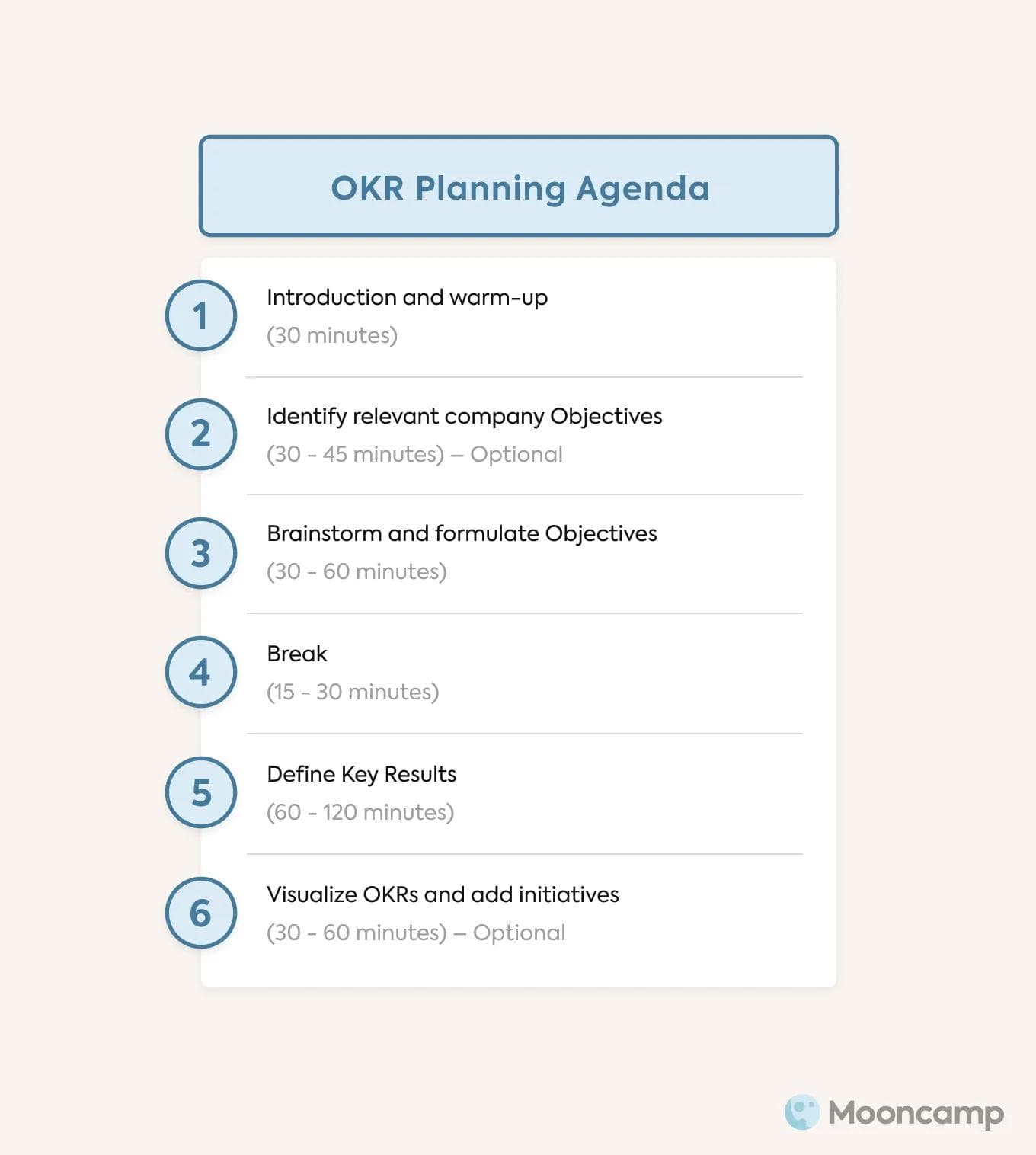
1. Introduction and warm-up
Before getting down to the nitty-gritty, the first part of the workshop should create a safe space for ideas and conversations. Participants should be able to adjust to the upcoming session and be encouraged to express their opinions. The best way to do this is with a casual round of introductions and a short icebreaker game. Some games that work well for this are:
- Two truths and a lie: All participants introduce themselves with two truths and one lie. Then everyone takes a turn guessing what was lied. Whoever guesses correctly receives one point. Whoever has the most points wins!
- Love bomb: All participants introduce themselves briefly with their name and picture. Then everyone is asked to compliment each other or name their best qualities at work. This boosts team morale and creates an appreciative atmosphere.
If the workshop takes place digitally, everyone also has the opportunity to get familiar with the tool during the warm-up. This way, the rest of the workshop runs more smoothly.
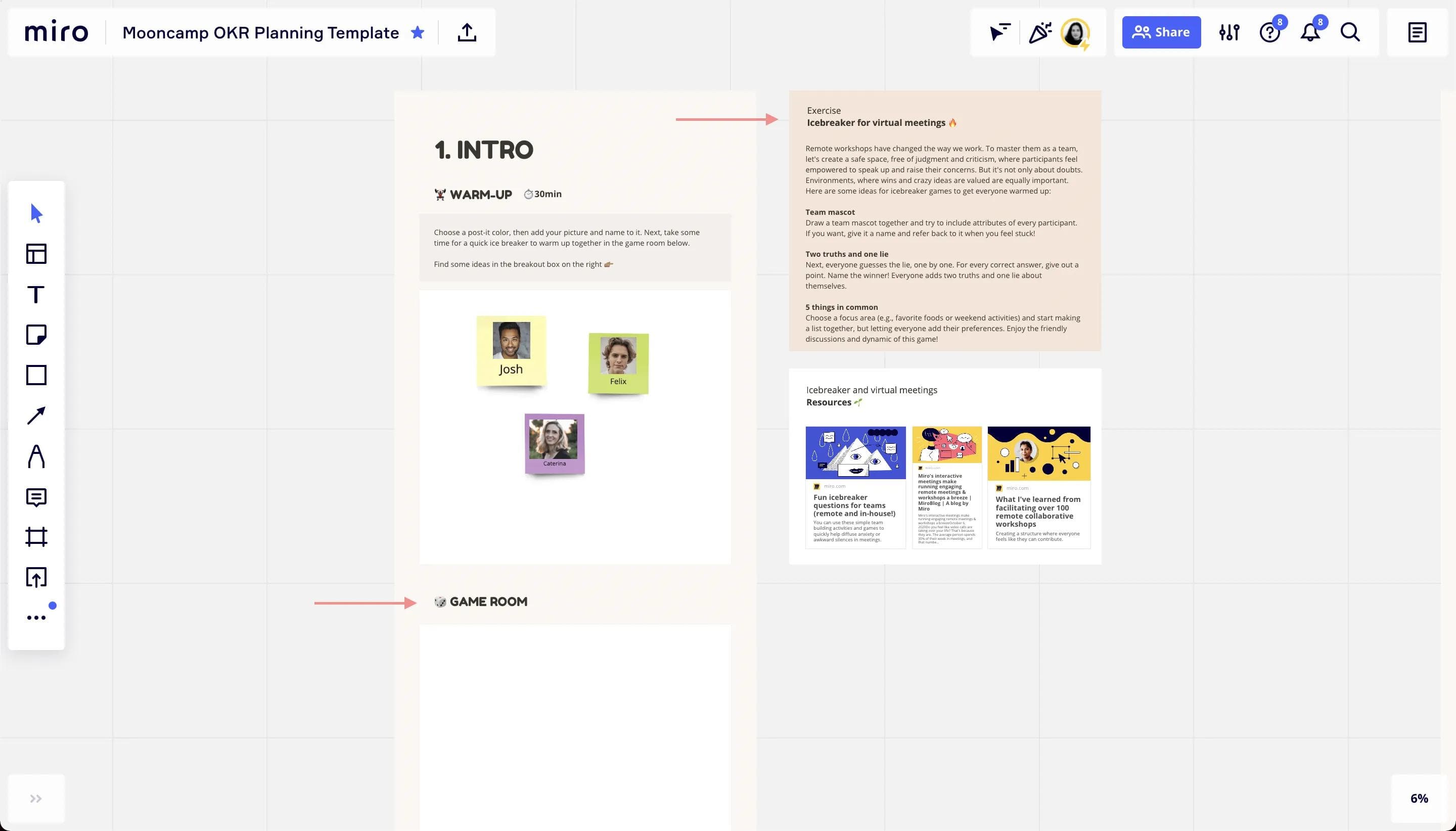
2. Identify relevant company Objectives (optional)
If the workshop is about team Objectives and Key Results, the main part optionally starts with a short discussion of which Key Results on a company level are relevant for the team. To do this, the entire team goes through the company OKRs together and the (senior) manager briefly explains the intention behind each OKR. The team then agrees on which Key Results can be best supported and impacted.
Ideally, the relevant company OKRs are prepared by the team leads and only briefly presented in the meeting. This leaves more time for the actual planning.
3. Brainstorm and formulate Objectives
In the first part of the brainstorming session, everything revolves around the Objectives. Ideally, all participants have already thought about these in advance. In the workshop itself, the process is as follows:
- All participants list their ideas for Objectives. This should take no longer than 10 minutes if everyone is well-prepared.
- The collected ideas are discussed in the team. The goal is to jointly identify the two to four best Objectives for the upcoming quarter.
- After making a selection, the team checks whether the selected Objectives are “good” Objectives. That is, whether they are inspiring and ambitious, among other things, but still achievable within the next cycle.
- Finally, it should be listed whether the achievement of the Objectives could depend on other teams or departments. If so, you should definitely seek discussion afterwards.
Overall, it is important that all participants agree with the formulated Objectives before the Key Results are created in the next step. Accordingly, the process may not always be linear. Objectives that have already been selected but do not meet the criteria should, for example, be discarded again or discussed and formulated anew.
💡 Tip: Our Miro OKR Planning Template includes, among other things, a “Will do/won't do” exercise as well as a checklist to help identify the most important OKRs. All criteria for good Objectives, as well as concrete tips for formulating them, can be found in our article “How to write OKRs: A guide for effective Objectives and Key Results”.
It is also important to note that while this process should be collaborative, it is not democratic. It is an interplay of top-down input and bottom-up ideas: Leaders guide the discussion, can veto, and ensure that the Objectives make strategic sense. Getting the entire team aligned on what Objectives to focus on can get pretty intense.
This makes it all the more important to take a break of 15 to 30 minutes before the next part of the workshop. This allows participants to recharge their batteries and come back with a fresh mind when it comes to addressing the Key Results next.
4. Define Key Results
After the break, the Objectives from the first part of the OKR planning session form the basis for brainstorming the Key Results. This follows a very similar pattern:
- All participants consider how to measure whether the previously formulated Objectives were reached. All ideas are initially written down in a list.
- Then, they select 2 to 4 Key Results per Objective from the list. There is no need to agree on concrete target values yet. However, it is important that the Key Results are measurable, outcome-oriented, and time-bound.
- Once the Key Results are defined, the team agrees on concrete (start and) target values for the next cycle.
- Finally, the team reviews how easy or difficult it will be to achieve the Key Results within this cycle. Completely overambitious Key Results and those that are too easy to achieve should be discussed and adjusted once again.
💡 Tip: Ideally, the Key Results should be completely consistent with the state that is targeted in the Objective. In other words: If all Key Results are achieved, the Objective is also fulfilled. Five Key Results that all look at the Objective from the same perspective are therefore less effective.
5. Visualize OKRs and add initiatives (optional)
Once all Objectives and Key Results are defined, they should be clearly visualized. An OKR tree diagram, for example, is suitable for this purpose. Concrete initiatives, i.e. To-dos, can then also be added to the individual Key Results in the overview. Depending on how much time and motivation is left at the end of the meeting, this can be done either directly or as follow-up. This part of these planning sessions is therefore optional.
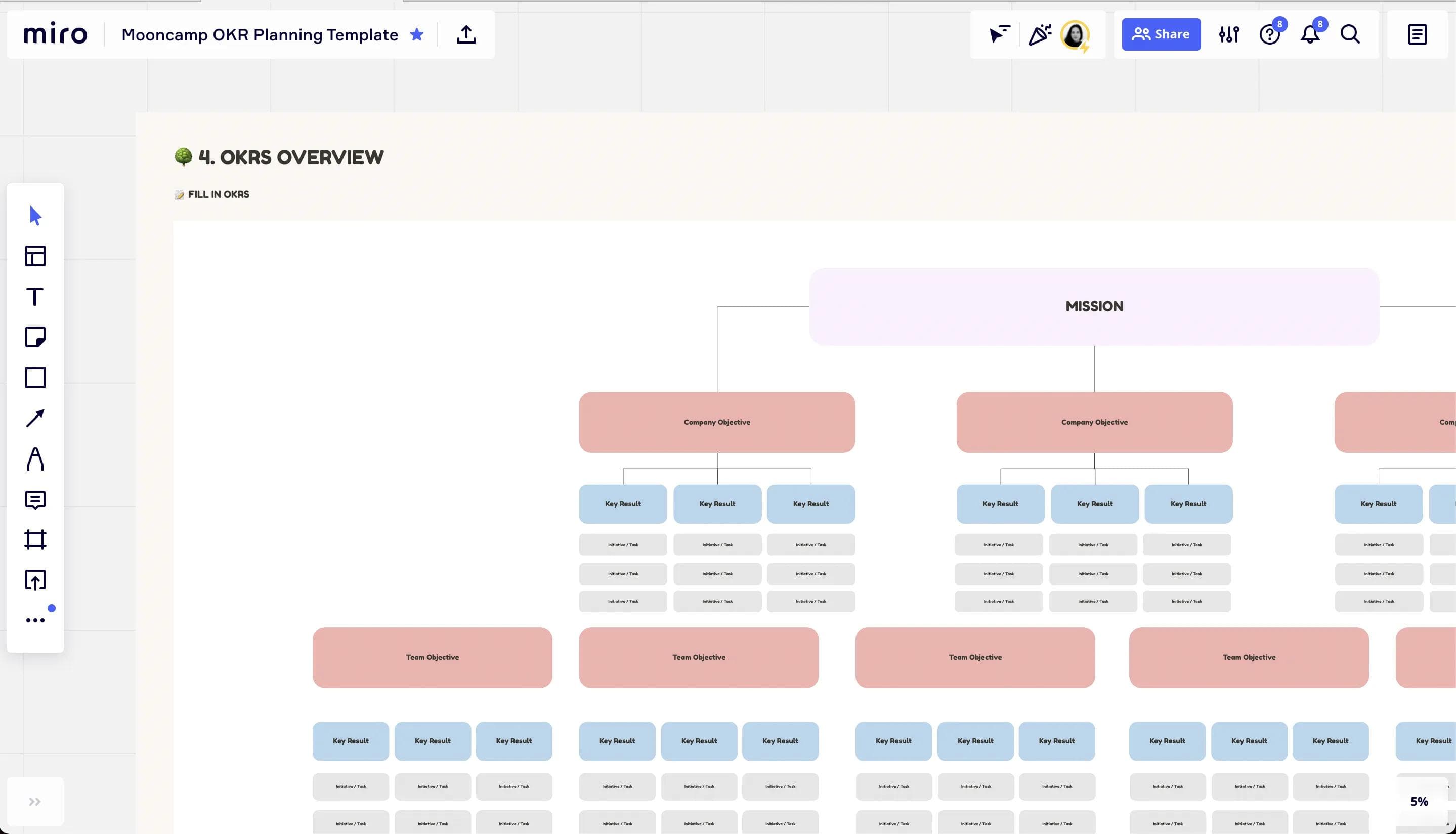
However, in case it is left out, it is important to clearly state who is responsible for the follow-up and when they will share the final overview with the team. Ideally, this should happen as soon as possible. In addition, the OKRs should be transferred from the OKR planning template into a tracking template (e.g. our Google Sheets OKR Tracking Template) or OKR software for further use.
How to plan OKRs with Mooncamp
Ready to get started? Mooncamp can also be used as an OKR planning tool. You can create as many planning spaces as you like directly in the software. In these closed virtual spaces, teams can capture their OKR drafts before they are published. The results of the OKR planning are thus collected right where OKRs will be tracked and managed later on.
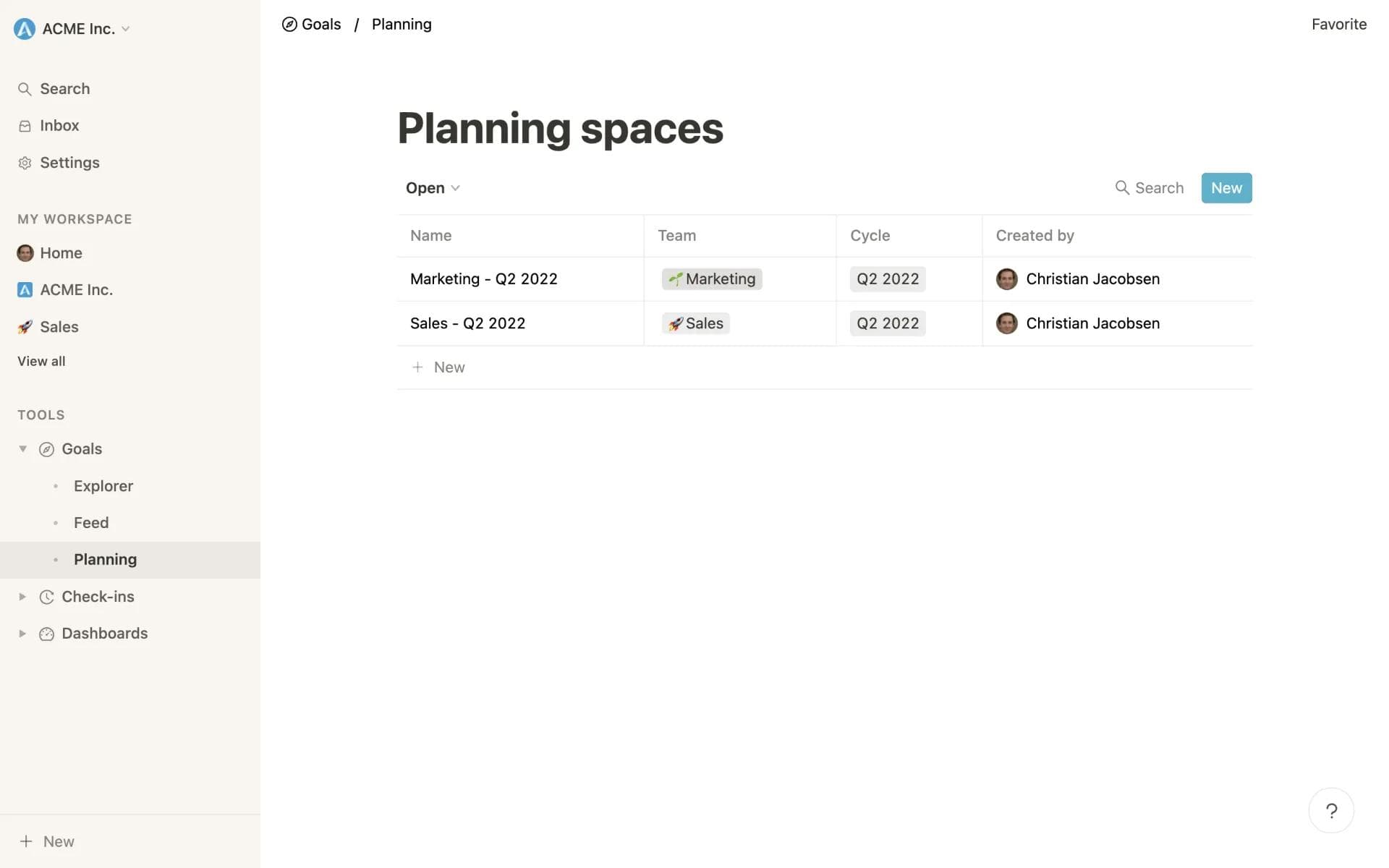
OKR Planning: FAQ
What is OKR setting?
OKR setting and OKR planning are often used synonymously. Both terms describe the process of creating and formulating Objectives and Key Results. They also refer to the corresponding event in the OKR cycle. OKR setting or planning always takes place shortly before or at the beginning of a cycle. Planning is usually done for one quarter.
How do you run an OKR planning meeting?
An OKR planning meeting always consists of at least three parts: (1) introduction and warm-up, (2) brainstorm and formulate Objectives, (3) define Key Results. If the planning is at team level, it is sometimes necessary to jointly identify the company OKRs to which the team contributes before the first brainstorming session. Optionally, initiatives can be added at the end of the meeting. It is critical for a productive meeting that all participants prepare well.
How do you facilitate an OKR discussion?
Beforehand, a safe space for exchange should be created through a casual round of introductions (e.g., with icebreaker games). Brainstorming should always follow a clear structure: First, ideas are collected. Then the ideas are discussed one after the other and, if necessary, voted on. The discussions should not go into too much detail. Detailed questions should be collected and, if necessary, clarified individually.

